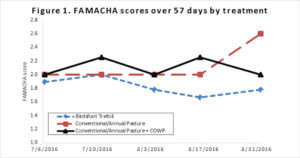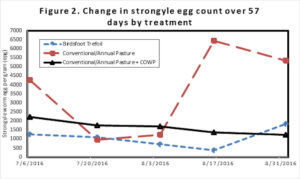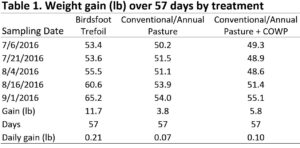2016 Annual Report for LNE13-327
Copper oxide wire particles to control H. contortus on sheep and goat farms with a range of grazing practices
Summary
Copper oxide wire particles (COWP), an alternative to chemical anthelmintics, have been shown to effectively reduce infection of barber pole worm (H. contortus) in the southeastern US. The objectives of this project are twofold. One objective is to encourage goat and sheep farmers to limit anthelmintic use through education on innovative strategies for controlling internal parasites including evasive grazing and targeted selective deworming. Dosing with COWP dosing and grazing high tannin forages such as birdsfoot trefoil (BFT) are as yet unproven in the northeastern US. Therefore a second objective was to determine the effectiveness and risks of incorporating COWP into northeastern parasite management systems and report results from COWP and BFT studies to farmers.
Twelve on-farm trials studying the effect of COWP dosing were conducted from 2013 through 2016. Data were entered into spreadsheets for further analysis. Preliminary studies of raw means indicate that COWP is effective on a few farms, but not most farms. We suspect that specific flock factors influence the amount of copper exposure actually experienced by susceptible worm populations in host animals. Breed, diet, timing of strongyle infection, and/or type of strongyle may influence effectiveness. However in-depth data analysis was postponed until 2017 because the student researcher required medical leave during 2016.
Approximately 178 people participated in three FAMACHA Certification workshops and four “Innovations in parasite management” workshops/presentations taught by our small ruminant team during 2016. Fifty four people representing 35 farms were certified in FAMACHA.
In March 2016, 553 past program participants were invited to participate in a follow up survey. Completed surveys were returned by 138 participants. Fifty two respondents indicated that they reduced their use of synthetic dewormers as a result of practices they adopted or improved upon because of our programs. Reported annual savings in dewormer costs ranged from $30 to $500, averaging $143. Few farmers provided monetary values from improved animal performance. When reported, earnings from improved animal productivity ranged from $100 to $1400 (average $557), savings in health costs (vet bills, labor to treat parasitized animals) ranged from $100 to $1000 (average $300), and savings from reduced animal mortality ranged from $400 to $2000 (average $1180). The survey will be released again in 2017.
Objectives/Performance Targets
Of 100 participating farmers surveyed, 75% will report deworming less and reducing their chemical dewormer costs by as much as $215 in a 100-doe or ewe flock, citing adoption of FAMACHA and other non-chemical internal parasite control methods. The low dose of COWP will reduce deworming cost by $142 compared with chemical dewormers with the added potential benefits of some farmers being able to meet organic farming standards and other farmers maintaining the effectiveness of selective use of chemical anthelmintics. Most importantly, these strategies both reduce deaths from internal parasites from as many as 18 animals per year to 5 animals per year, increasing income by $2,205 in a herd or flock of 100 mature females.
Accomplishments/Milestones
Milestones
- Three-thousand sheep and goat farmers learn about this research and extension project and are directed to an on-line survey about their methods of controlling H. contortus and other internal parasites. In May 2014 our database of >3000 sheep and goat farmers was invited to participate in the preliminary survey. Valid emails and further mis-identification of the email invitation as spam resulted in about 1200 addresses receiving the announcement.
- Five-hundred farmers complete the survey and 300 agree to receive additional information about controlling H. contortus with minimal use of chemical anthelmintics. Of 194 respondents within one month of the invitation, 168 respondents fully completed the survey and agreed to receive additional information. However, attendance at our workshops providing information on controlling H. contortus with minimal use of chemical anthelmintics has easily doubled 300 people by 2017.
- Two-hundred farmers attend field days, workshops at regional conferences, or extension programs to learn directly about control of H. contortus and other internal parasites using COWP and other methods, such as FAMACHA scoring, evasive pasture management, and forages high in condensed tannins. Twelve farmers agree to do the research with COWP. Approximately 922 people (not checked for duplicates yet in 2016) have attended our integrated parasite management workshops, field days and FAMACHA certification programs, 389 people have been certified in FAMACHA and ~600 farmers have provided follow up contact info to track their parasite management changes.
- Seven farmers carry out the research with COWP. One-hundred participating farmers respond to follow up questionnaires or interviews on changes made in internal parasite management. Nine NY farmers have participated in 12 COWP studies. We are also conducting studies on the effect of grazing Birdsfoot Trefoil on parasitic worm infections in sheep and goats. Eleven Northeast farmers have established their BFT field and ten have completed grazing trials. Two of these combined the use of both BFT and COWP in their studies. Invitations to complete a follow up survey were sent to 553 workshop participants and 138 completed surveys were returned. We plan to send the invitation to more recent workshop participants during the spring of 2017.
Progress, changes and actions still needed
Participation in workshops and on-farm studies has exceeded our expectations. Detailed statistical analyses are still needed to try to determine why COWP dosing was very effective for 3 years in a row at one farm but showed only temporary or no effect at other farms. The graduate student using the data for a MS thesis required unexpected medical leave in 2016, thus delaying some analyses. Given the variable responses of parasitic worms to COWP dosing and BFT grazing in the on-farm trials, it is difficult to advise workshop participants on how and whether to incorporate these practices into an integrated parasite management plan. Recommendations in workshops include monitoring animals after COWP dosing to evaluate whether dosing is effective in individual herds and consideration of other benefits of BFT grazing by study farmers, such as improved FAMACHA scores and weight gains, especially in grass-fed market animals. Invitations to participate in the follow up survey will be sent to more recent participants this spring or summer assuming sufficient time to begin implementing new parasite control practices and/or document improvements as a result of education. Factsheets will be developed and posted online summarizing study results and discussing when and how to incorporate BFT and COWP into integrated parasite management programs.
Impacts and Contributions/Outcomes
In 2016, one on-farm BFT grazing trial included the use of COWP dosing. Nine Kiko male goat kids each were assigned to one of two forage treatments, either rotated through pastures with 25% or more birdsfoot trefoil (Bruce variety) for 8 weeks or set stocked on a conventional pasture of cool season grasses and clover for 4 weeks and then rotated through an annual pasture mix of millet, cowpeas, and brassicas for 4 weeks. Four of the nine kids in the Conventional/Annual Pasture group (CAP) were dosed with 2 grams of COWP each (CAP + COWP) 4 weeks into the study when rotated onto the annual pasture.
Preliminary study of raw means seems to indicate that the BFT group averaged lower FAMACHA scores, lower strongyle worm egg counts and increased weight gains compared to the CAP group (Figures 1 and 2, Table 1). However, average strongyle egg counts did increase in the BFT group during the last two weeks when the remaining pasture was mowed to 6 to 10 inches to combat excessive maturity. Although a new section of pasture was opened every 4 to 5 days, the group could backtrack up to 14 days in order to access their shelter. The CAP + COWP group did not experience the sharp increase in average strongyle worm egg counts exhibited by the CAP group during the last 4 weeks of the grazing trial and average FAMACHA score at 8 weeks was also lower (Figures 1 and 2). Daily weigh gains averaged 0.21, 0.07 and 0.10 lb over the 57 day grazing trial for BFT, CAP and CAP + COWP, respectively (Table 1).
A pre and post quiz was administered to participants at three FAMACHA Certification workshops and two “Innovations in parasite management” workshops during 2016 to track changes in knowledge. Average percentage of correct answers improved from 45% to 73%, 57% to 91%, 45% to 63%, 73% to 83%, and 61% to 75% for FAMACHA workshops in Saratoga County (NY), Madison County (NY) and Ontario County (NY), and “Parasite Innovation” presentations at the Vermont Grazing Conference and the NOFA-NY Winter Conference respectively. Changes planned by the 54 farmers completing post quizzes included: answer left blank (19 farmers), growing BFT for grazing or looking into it more (15 farmers), starting/improving evasive grazing (12 farmers), increasing frequency of FAMACHA checking (10 farmers), trying out COWP dosing (6 farmers) , implementing targeted selective deworming (5 farmers), starting/improving fecal egg counting (4 farmers), changing flock nutrition (prenatal feeding, better mineral/vitamin supplementation) to boost the immune system (2 farmers), and no change (2 farmers). One farmer each planned to improve their technique for administering dewormers, begin multispecies grazing, genetically select for parasite resistance or consult with their veterinarian about the use of Covexin 8 vaccines in high risk liver fluke areas.
One hundred and seventy participants representing NY (62%), VT (17%), MA (6%), PA (5%), CT, NH, NJ, OH, ON, QC and RI responded to a 41 question follow up survey with 138 respondents completing it entirely. Sixty two respondents indicated that they adopted FAMACHA alone or in combination with a 5 point check to selectively deworm animals as a result of our programs while 21 respondents indicated they already used these practices and made no change, 31 improved on these practices and 6 planned to adopt soon.
When asked if they reduced their use of synthetic dewormers as a result of practices they adopted or improved upon because of our programs, 46% (52 farmers) said “yes”, 31% (35 farmers) were unsure and 24% (27 farmers) said “no” either because of no reduction or because of already reducing or eliminating use. Annual savings in dewormer costs reported by respondents because of adoption of the recommended practices ranged from $30 to $500, averaging $143.
About a third of the farmers indicated that they had seen an improvement in animal health and/or performance as a result of adoption of these practices. However, only few were able to estimate a dollar value for these improvements. Seven, ten, and five farmers, respectively, gave monetary values for 1) earnings from improved animal productivity ranging from $100 to $1400 (average $557), 2) savings in health costs (vet bills, labor to treat parasitized animals) ranging from $100 to $1000 (average $300), and 3) savings from reduced animal mortality from parasites ranging from $400 to $2000 (average $1180).
Twelve farmers reported feeling more confident about their transition to organic small ruminant production because of practices they adopted from attendance at our programs while 62 farmers indicated that they have no plans to be organically certified but have increased confidence in managing gastrointestinal parasites without regular use of synthetic dewormers. About 71% of respondents planning to start raising goats/sheep also reported increased confidence and 71% of veterinarians and educators felt more confident in advising goat and sheep farmers on parasite management.
An abstract summarizing the results of our earliest COWP study at a commercial goat dairy was submitted for the 3rd National Goat Conference scheduled for February 2017 in Tuskegee, AL. However, the conference is postponed until September 2018 and we may resubmit the abstract to another conference. Preliminary results from several of our studies were reviewed in an 8 page paper in the Proceedings of the 22nd Annual Dairy Sheep Association of North America Symposium, Ithaca, NY Dec 2-4, 2016.
Further analyses of our COWP and BFT studies will 1) provide better clues as to why the efficacy of COWP varies so much among farms and 2) help determine whether the use of BFT pastures for weaned lambs and kids is justified despite difficulties in establishing BFT and slow regrowth in comparison to conventional clover/grass pastures. Increased farmer knowledge to make wise decisions about adopting tools such as targeted selective deworming, evasive grazing, BFT grazing and COWP dosing into their integrated parasite management programs can substantially improve the sustainability of sheep and goat farmers in the northeastern United States.



Collaborators:
Extension Educator
St. Lawrence County
2043 State Highway 68
Canton, NY 13617
Office Phone: 3153799192
Professer
Cornell University
College of Veterinary Medicine
Ithaca, NY 14853
Office Phone: 6072533140
Extension Associate
Cornell University
114 Morrison Hall
Ithaca, NY 14853
Office Phone: 6072546024